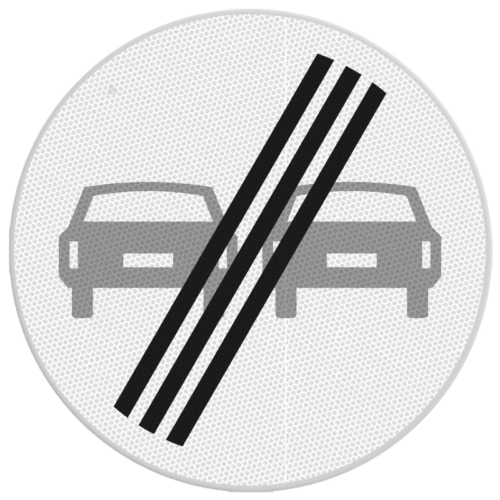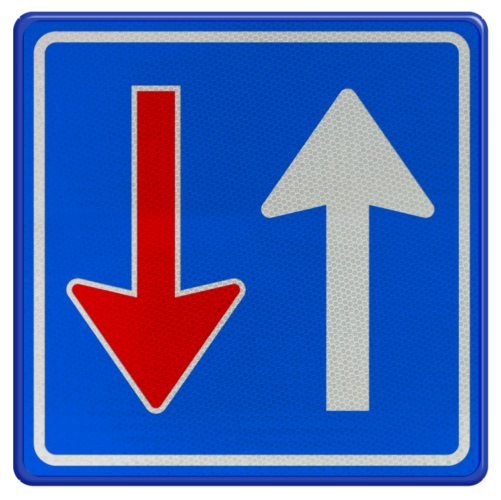Category F – Other commandments and prohibitions
 Sign F1 – Prohibition for motor vehicles to overtake each other.
Sign F1 – Prohibition for motor vehicles to overtake each other.
Once you pass this sign, you are no longer allowed to overtake other motor vehicles. You are, therefore, not allowed to overtake a tractor, brommobiel, or motorcycle here with a motor vehicle. And not the other way around. This sign is usually placed in places where overtaking is not possible due to, for example, a narrow road or in places where overtaking can lead to dangerous situations.
A ban on motor vehicles overtaking each other often indicates a change in the road (environment).
Look far ahead to discover in time what this change consists of. This could be roadworks, a sharp, unclear bend, or a narrowing or split in the carriageway.
Despite an overtaking ban, sometimes harried drivers do not care. Be aware of this. If the roadway width is more than 5 meters, the sign will also be placed on the left side of the roadway. A sign can permit overtaking agricultural vehicles.
 Sign F2 – End of prohibition for motor vehicles to overtake each other.
Sign F2 – End of prohibition for motor vehicles to overtake each other.
From this sign, it is again permitted to overtake motor vehicles.
Keep in mind that many drivers will usually try to do this right away. Some drivers overtake before they have passed the sign.
 Sign F3 – Prohibition on lorries overtaking motor vehicles.
Sign F3 – Prohibition on lorries overtaking motor vehicles.
After passing this sign, trucks are not allowed to overtake motor vehicles. Therefore, lorries are not allowed to overtake passenger cars, tractors, brommobielen, or motorcycles.
This sign is strategically placed in areas where slower trucks might impede the flow of traffic, ensuring that drivers are well informed and prepared for such situations.
Buses, motorcycles, and passenger cars are allowed to overtake other motor vehicles if this sign is placed.
A sign indicating the duration of the ban is often placed on motorways. For example, from 6 a.m. to 10 a.m. and 3 p.m. to 7 p.m. These times have been deliberately chosen to relieve the busy rush hour traffic. During these times, trucks are not allowed to overtake. Outside these times, yes.
The sign also occurs on slopes.
 Sign F4 – End of the ban on lorries overtaking motor vehicles.
Sign F4 – End of the ban on lorries overtaking motor vehicles.
When this sign is placed, lorries are allowed to overtake motor vehicles.
Keep in mind that in a row of lorries, there may always be one or more lorry drivers who immediately want or will overtake the slower lorries. This may cause the speed to be lower than you were used to.
You will also encounter this sign on descents after a slope.
 Sign F5 – Prohibition for drivers to proceed when approaching traffic from the opposite direction.
Sign F5 – Prohibition for drivers to proceed when approaching traffic from the opposite direction.
If you come across this sign as a driver and there is oncoming traffic, you must give way. When a pedestrian approaches this sign, he does not have to give way to drivers from the other direction. Because…. a pedestrian is not a driver, and this sign only applies to drivers. As a driver, you must give way to all traffic; a pedestrian is traffic. So, the pedestrian goes first in every respect.
This sign is often found at road narrows, roadworks, and narrow bridges. On the other side of the narrowing is the following sign: F6.
During road works, this sign is usually placed on the side where traffic should pass on the side of the road in front of oncoming traffic.
Most people look at the color of the arrows with this sign and sign F6. But what should you look for when it has snowed, and the color of the arrows is no longer visible? Do you want to wipe away the snow? It is more convenient to look at the shape of the board. At the round board, you must let everyone go first.
You may continue at the square sign unless pedestrians are approaching from the other side. Then you have to let the pedestrians go first.
 Sign F6 – Drivers from opposite directions must give way to traffic approaching from this direction.
Sign F6 – Drivers from opposite directions must give way to traffic approaching from this direction.
You may continue when approaching a narrowing with this sign on this side unless pedestrians are approaching from the other side. Then you have to let the pedestrians go first.
This sign is often found at road narrows, roadworks, and narrow bridges. On the other side of the narrowing is the previous sign: F5.
During road works, this sign is usually placed on the side of the road where traffic does not have to be in front of oncoming traffic.
Most people look at the color of the arrows with this sign and sign F5. But what should you look for when it has snowed, and the color of the arrows is no longer visible? Do you want to wipe away the snow? It is more convenient to look at the shape of the board. At the round board, you must let everyone go first.
You may continue at the square sign unless pedestrians are approaching from the other side. Then you have to let the pedestrians go first.
 Sign F7 – U-turn prohibition.
Sign F7 – U-turn prohibition.
A U-turn at this sign is not allowed. However, turning left is allowed.
It’s essential to understand the rationale behind this sign. The speed of traffic here is high, and unfamiliar drivers often find themselves driving in the wrong direction, attempting to make a U-turn. This is precisely why this sign, which prohibits such actions, is necessary.
This sign is placed on the left side of the carriageway, in a deviation from the usual placement. Undersigns allow this sign to apply to or exclude specific categories of vehicles.
 Sign F8 – End of all prohibitions indicated by traffic signs.
Sign F8 – End of all prohibitions indicated by traffic signs.
This sign ends all prohibitions given by traffic signs. You often see this sign after roadworks. During roadworks, a lower speed limit and an overtaking ban often apply. This sign is placed to avoid having to place two signs. After this sign, the standard speed limit applies again.
It’s important to note that after a speed limit (and overtaking ban), some motorists may start accelerating well before the F8 sign. Therefore, it’s crucial to be vigilant of the traffic behind you when overtaking.
 Sign F9 – End of all prohibitions indicated on an electronic signaling board.
Sign F9 – End of all prohibitions indicated on an electronic signaling board.
 Sign F10 – Stop. The sign can indicate who or why the sign is being used.
Sign F10 – Stop. The sign can indicate who or why the sign is being used.
This sign indicates that you must stop.
You used to come across this sign at the border posts. Since the abolition of land borders within the European Community, this sign is no longer placed within the EC.
If an attendant of a rail vehicle shows a stop sign with this sign, a red flag, or a red lamp, road users are obliged to stop.
Traffic officers, our dedicated guardians of road safety, also carry these signs at crossings, including those near schools. When a traffic sergeant holds up a sign like this, it’s a clear signal for you to stop, ensuring your safety and that of others.
When performing their duties, traffic sergeants must at least be equipped with:
- an orange fluorescent jacket or vest and
- a stop sign using this sign.
The stop sign comes in two versions:
- as a stop sign held up by hand.
- as a stop sign that is part of a rotating arm system.
Do not confuse the meaning of this sign with sign B7. If sign B7 has been placed, you may continue driving if you have come to a complete stop and there is no traffic approaching. You must wait at this sign until it indicates that you can continue driving.
 Sign F11 – Mandatory use of passing lane or passing carriageway (lane or carriageway for overtaking), exclusively intended for agricultural and forestry tractors, motor vehicles with limited speed, and mobile machines.
Sign F11 – Mandatory use of passing lane or passing carriageway (lane or carriageway for overtaking), exclusively intended for agricultural and forestry tractors, motor vehicles with limited speed, and mobile machines.
 Sign F12 – End of mandatory use of passing lane or passing carriageway (lane or carriageway for overtaking), exclusively intended for agricultural and forestry tractors, motor vehicles with limited speed, and mobile machines.
Sign F12 – End of mandatory use of passing lane or passing carriageway (lane or carriageway for overtaking), exclusively intended for agricultural and forestry tractors, motor vehicles with limited speed, and mobile machines. Sign F13 – Carriageway or lane exclusively for scheduled buses.
Sign F13 – Carriageway or lane exclusively for scheduled buses.
 Sign F14 – End of carriageway or lane exclusively for scheduled buses.
Sign F14 – End of carriageway or lane exclusively for scheduled buses.
 Sign F15 – Carriageway or lane exclusively for trams.
Sign F15 – Carriageway or lane exclusively for trams.
 Sign F16 – End of carriageway or lane exclusively for trams.
Sign F16 – End of carriageway or lane exclusively for trams. Sign F17 – Carriageway or lane exclusively for scheduled buses and trams.
Sign F17 – Carriageway or lane exclusively for scheduled buses and trams.
Sign F18 – End of carriageway or lane exclusively for scheduled buses and trams.
 Sign F19 – Carriageway or lane exclusively for trucks and scheduled buses.
Sign F19 – Carriageway or lane exclusively for trucks and scheduled buses.
Sign F20 – End of carriageway or lane exclusively for trucks and scheduled buses.
 Sign F21 – Carriageway or lane exclusively for lorries.
Sign F21 – Carriageway or lane exclusively for lorries.
Sign F22 – End of carriageway or lane exclusively for lorries.
